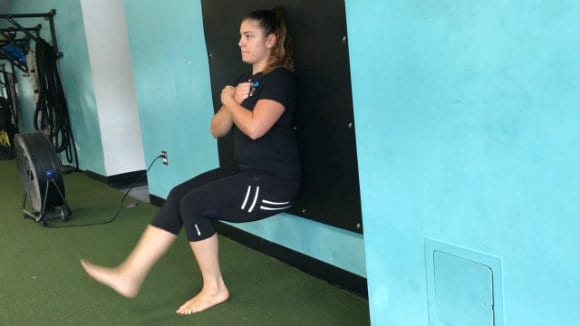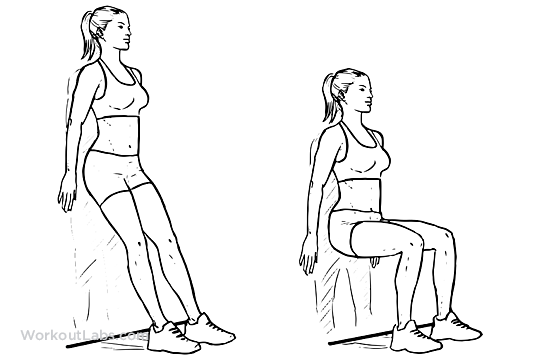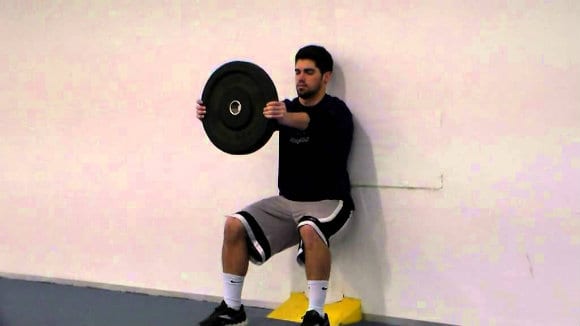By the healthiergang writer Gabriele Galasso, Functional Training instructor and K1 competitive athlete.
Wall Sit
The wall sit (also known as "wall chair" in your local language) is one of the best isometry exercises for the lower limbs.
This apparently trivial exercise (I remember infinite warm-ups in the hours of physical education in middle school using this type of isometry) must however be considered among the advanced exercises as all the exercises in isometry.
Although the execution is quite simple, an untrained athlete would be able to resist a short time in the correct position, risking to change their posture with a consequent increase in the probability of injuries.
On the other hand, however, in a bodyweight version, the wall sit could be used in small doses as a prerequisite for the squat for those who have recently entered the gym ... in short, an exercise that is not simple but in small doses and with criteria it can be used by novices and not.
Muscles involved
The muscles most involved are those of the lower limbs, in particular quadriceps, calves and buttocks.
Recall that since this is an isometry exercise (muscle contraction in the strict sense, without shortening and lengthening the muscle), the benefits are multiple: the basic principle is to reach a state of muscular exhaustion, imposing a contraction not generated by movement, but by the maintain a static position trying only to oppose your own weight strength (possibly added by overloads in the case of very hard workouts).
The resulting benefits are an increase in muscle mass, tone and strength.

How is it done?
The execution of the wall sit is quite simple from the point of view of posture ... the main problem is to maintain the correct position for the time required.
- position yourself with your back to a wall
- lean your back against the wall, keeping it snug against it and placing your feet at a distance equal to your femur from the wall
- in this position, the tibia and femur form an angle of about 90 ° or a little more (no less !!)
- lean the back of the neck against the wall and keep your hands at your sides
- hold the position for the set time

Mistakes To Avoid
The main mistakes that can be made in the wall sit can be summarized as follows:
- back close to the wall, starting from the buttocks to the nape of the neck.
- shoulder blades well adducted while maintaining a neutral and relaxed position of the shoulders
- weight distributed on the back of the foot and not on the toes
- hands at your hips and not resting on your knees
variants
More advanced athletes can venture into some progressions (we'll see two of them) to vary the stimulus of the wall sit and make their workouts more fun.
1. Wall sit with overload
In this case, the element different from the classic case is the weight to be won: using an overload, maintaining the isometry for the same time will be a very difficult undertaking.
For example, you can use a kettlebell held as for the execution of a goblet squat, with both hands on the sides of the handle and the elbows wedged on the hips, forming the classic "goblet" posture.

2. Balance wall sit
In this case, the increase in difficulty lies in the “unbalcance” component inserted by a balance board or a bosu ball.
The position to be maintained is the same as in the bodyweight case with the difference that the feet are positioned on the imbalance tool, thus making the workout even more functional especially for sports such as hockey, skiing and skating.
Nobody forbids, for example, to combine both progressions by performing a wall sit with overload resting on a balance board.
Sheet
The applications of this exercise are so many that it is impossible to list them all, as the purpose of the training could focus on multiple objectives, so I will limit myself to giving an example for a basic workout and one for a really grueling workout.
1. Workout base
Timed pyramid: 10 ″? 40 "? 10", following the proposed scheme
- wall sit 10″
- rest 10″
- wall sit 20″
- rest 20″
- wall sit 30″
- rest 30″
- wall sit 40″
- rest 40 “
- wall sit 30″
- rest 30″
- wall sit 20″
- rest 20″
- wall sit 10″
- rest 10″
2. Advanced Workout
Little time to train your legs? let's set aside 4 minutes all for them at the end of the workout, doing a nice tabata where our wall sit will be the rest:
Tabata protocol: 20 ”of work 10” of rest for 8 series: total 4 minutes of work
20 ": perform as many goblet squats as possible (with a not too high load, for example a 16 kg kb for a man)
10 ″: “rest” in wall sit keeping the kettlebell in the chest with the elbows tight
Note: to make the workout even more stimulating, especially if in a group, count the repetitions performed every 20 ″ and keep in mind the lowest number of the 8 series. At the end of the workout, compare yourself with your teammates and the athlete who has scored the fewest repetitions performs 50 burpees in front of their teammates. Seeing is believing.


























